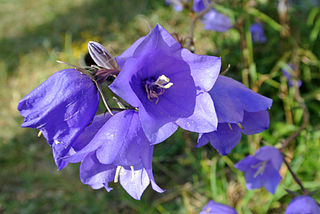
Campanula is the type genus of the Campanulaceae family of flowering plants. Campanula are commonly known as bellflowers and take both their common and scientific names from the bell-shaped flowers—campanula is Latin for "little bell".

The family Campanulaceae, of the order Asterales, contains nearly 2400 species in 84 genera of herbaceous plants, shrubs, and rarely small trees, often with milky sap. Among them are several familiar garden plants belonging to the genera Campanula (bellflower), Lobelia, and Platycodon (balloonflower). Campanula rapunculus and Codonopsis lanceolata are eaten as vegetables. Lobelia inflata, L. siphilitica and L. tupa and others have been used as medicinal plants. Campanula rapunculoides may be a troublesome weed, particularly in gardens, while Legousia spp. may occur in arable fields.

Sigmund Zois Freiherr von Edelstein, usually referred as Sigmund Zois was a Carniolan nobleman, natural scientist and patron of the arts. He is considered one of the most influential figures of the Enlightenment Era in the Slovene Lands of Habsburg Austria.

Campanula rapunculoides, known by the common names creeping bellflower, rampion bellflower, rover bellflower, garden bluebell, creeping bluebell, purple bell, garden harebell, and creeping campanula, is a perennial herbaceous plant of the genus Campanula, belonging to the family Campanulaceae. Native to central and southern Europe and west Asia, in some parts of North America it is an extremely invasive species.
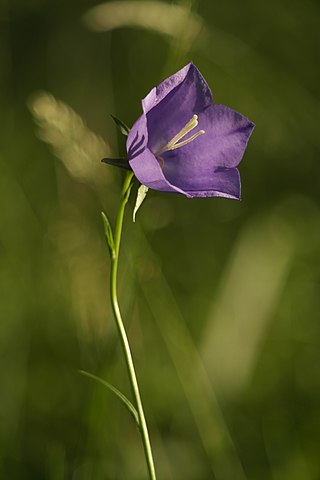
Campanula persicifolia, the peach-leaved bellflower, is a flowering plant species in the family Campanulaceae. It is an herbaceous perennial growing to 1 m. Its flowers are cup-shaped and can be either lilac-blue or white. Its foliage is narrow and glossy with a bright green appearance.

Campanula patula or spreading bellflower is a plant species of the genus Campanula. It can grow to more than half a meter high. This delicate bellflower bears lateral branches of pale blue or white flowers that are upright and funnel shaped. The leaves are narrow and pointed. Branches are often supported by the surrounding vegetation, so the plants can appear prostrate. The main difference between this and other bellflowers is that the petals in the bell are spread out and more pointed and this gives this species its common name.

Campanula gelida is a stenoendemic, critically endangered species of flowering plant in the bellflower family Campanulaceae. It is a perennial species that grows in the mountains of Hrubý Jeseník in the Czech Republic. It evolved through specialization of an isolated population of Campanula scheuchzeri, an Alpine species, which expanded to the area of the Sudetes during a colder period, probably the last ice age. It is closely related to Campanula bohemica, endemic to the Giant Mountains. Sometimes it is even considered its subspecies and referred to as Campanula bohemica subsp. gelida. They all belong to the group of related species Campanula rotundifolia agg.

Campanula poscharskyana, the Serbian bellflower or trailing bellflower, is a semi-evergreen trailing perennial, valued for its lavender-blue star-shaped flowers. It is native to the Dinaric Alps in former Yugoslavia.

Campanula portenschlagiana, the wall bellflower, is a species of flowering plant in the family Campanulaceae, native to the Dalmatian Mountains in Croatia. It is a vigorous, low-growing, mound-forming evergreen perennial with deep purple flowers in summer. Other common names include Dalmatian bellflower, Adria bellflower and Campanula muralis.
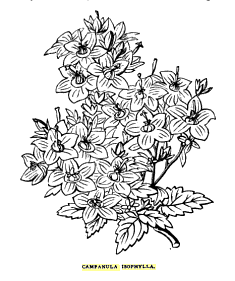
Campanula isophylla is a species of plant. The common names of the species include Italian bellflower, star of Bethlehem, falling stars and trailing campanula.

Cyclamen purpurascens, the purple cyclamen, is a species of flowering plant in the genus Cyclamen of the family Primulaceae, native to central Europe, northern Italy, and former Yugoslavia. It is an evergreen tuberous perennial with (usually) variegated leaves, and deep pink flowers in summer.

Karl von Zois zu Laibach was a Carniolan amateur botanist and plant collector. He is best known today as the namesake of zoysiagrass, which was named by Carl Ludwig Willdenow in 1801. The bellflower Campanula zoysii is also named after him.

Campanula punctata, the spotted bellflower, is a species of flowering plant in the bellflower family Campanulaceae. This ornamental herbaceous perennial is native to Japan, Korea, China and Siberia, and is widely cultivated for its attractive bell-shaped flowers.

Campanula piperi is a species of flowering plant in the bellflower family, Campanulaceae. It is native to the Olympic Mountains on the Olympic Peninsula in the U.S. state of Washington. It has also been noted on Vancouver Island, British Columbia.
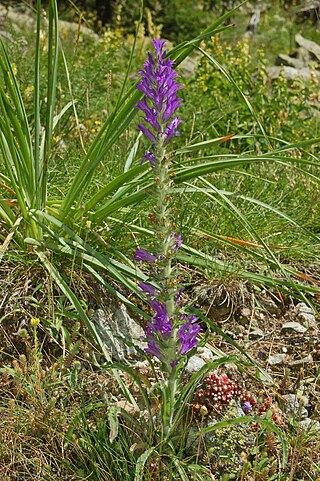
Campanula spicata, common name the spiked bellflower, is a herbaceous biennial or perennial plant of the genus Campanula belonging to the family Campanulaceae.

Campanula raineri is a species of flowering plant in the genus Campanula of the family Campanulaceae, native to the Swiss and Italian Alps. It is a low-growing herbaceous perennial growing 5–8 cm (2–3 in) tall by up to 20 cm (8 in) wide, with pale lilac bell-shaped flowers in summer. It is suitable for cultivation in the alpinum or rock garden. It spreads by underground runners. Its locus classicus is located in Canzo, Lombardy.

Campanula betulifolia, the birch-leaved bellflower, is a flowering plant in the family Campanulaceae, native to Turkey, where it grows in crevices in volcanic cliffs. The plant was named in 1850 by the German botanist Karl Koch, following plant-collecting expeditions to the Caucasus.
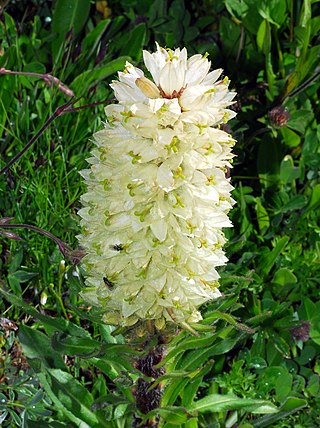
Campanula thyrsoides is a flowering plant belonging to the family Campanulaceae.

Campanula tommasiniana, known as the Croatian bellflower or Tommasini bell flower, is a perennial species of flowering plant in the family Campanulaceae. It is native to the alpine regions of Croatia. It has gained the Royal Horticultural Society's Award of Garden Merit as an ornamental.

Črna Prst is a mountain in the southeastern Julian Alps, located at the edge of Triglav National Park. Standing at 1,844 metres (6,050 ft), it is the 370th–highest peak in Slovenia. In the interwar period, the mountain ridge marked the border between the Kingdom of Italy and the Kingdom of Yugoslavia.






















